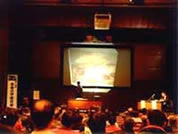TOP > Topics > 2002 > Sagamihara Space School
![]()
Sagamihara Space School
Space School was held this time under the themes of "Solar System" (162 participants), "Space Technology" (142) and "Black Holes" (140). The Solar System session covered interesting topics such as a comet collision,the origin of life in outer space and Mars meteorites, and the questions raised on life in space were relatively familiar and simple. At the beginning of the session delivered by National Astrospace Laboratory, more than 90% of the participants answered yes to the question "Do you want to travel through space?" It seemed there was a favorable wind blowing for the rocket development that is designed to send people to space, such as reusable launch vehicles, round-trip vehicles, etc. As for space power generation, questions about its cost and security were raised as we had expected. The topic where most questions focused was of course "black holes". With recent media hype, questions took on a look of Zen dialogue such as "What becomes of black holes at the end?", "What happens to space after that?" and "What is nothing?" The audience did not look entirely satisfied with our answer, "We are not sure about it yet", which was given to all the questions except those that have verified findings or theoretically obvious conclusions. They seem to feel reassured with answers that are presented as definite facts, even when they are actually only hypotheses. Such a different approach to findings may afford a clue to our future PR activities.
Meantime, some other questions raised this time indicated current public interest, and I think I am not the only one who realized that the topics through which the new integrated space institute could obtain most support from the public are "intellectual curiosity" and "human deployment into space". Lastly, let me express our gratitude to the people concerned for their cooperation and support to carry out this event.



April 24, 2002




